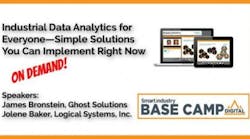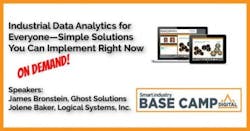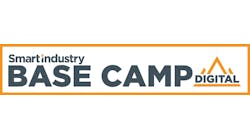Base Camp Digital Presenters: Data analytics for everyone
Is a data-driven approach achievable for all manufacturers, no matter their size / background / field of focus?
Yes, say Jolene Baker and James Bronstein, who presented the Base Camp Digital webinar (which you can access on demand) “Industrial Data Analytics for Everyone—Simple Solutions You Can Implement Right Now.”
Below we pick their brains about the universal value of diving deep into data. Take a look…
Jolene, senior manufacturing intelligence specialist, Logical Systems Inc.: I often look at data analytics as an extension of human intuition. Analytics are used everywhere in manufacturing, from defining the smallest quantifiable item to creating intelligence around larger process patterns. Analytic results provide us a way to present what we thought we knew. We use them to expand our opportunities. To summarize, all businesses benefit from analytics but the implementation and complexity of the smart data-driven strategy will be dependent upon the organization’s size.
James, principal engineer, Ghost Solutions: From my perspective, advanced data analytics aren't utilized fully, however they are applicable everywhere and can provide a competitive edge in increased productivity and profits. The smallest shop or manufacturer could benefit from data-driven solutions. The key thing to note is that data-analytic solutions are not a one-stop shop; their cost and time to deploy depends on the organization's size, processes and (most important) their business culture.
Smart Industry: Are there misconceptions about the number of enterprises / the degree to which enterprises are analyzing their data?
Jolene: Data is like a secret sauce…enterprises only share their final dish, never the ingredients. Analogies aside, data is my job so I see ‘tons’ of opportunity everywhere I visit.
James: From my experiences, almost all business are analyzing their data at some level. The difference is the level of data analytics being used. Some organizations are utilizing massive Excel spreadsheets that are updated manually for daily review and analysis, while others have moved to an automated analytical solution that requires connecting everything from manual log sheets to the advanced process-control system to realize the benefit. Of course the most important work for the benefit to be realized long-term is the training and culture change for a business to be data driven.
Smart Industry: What's a common simple first step with using the information coming off machines?
Jolene & James: The first step is identifying the problem or efficiency you would like to improve or solve. Focus on finding the data to resolve the problem, versus looking through a massive amount of data trying to find a problem that could be solved. You want to avoid the collecting-all-data trap. Not that the data is not valuable and potentially useful, it will just slow down and increase the cost of an organization’s data-driven solution as they start this journey. Data silos are common low-hanging fruit that can be solved with today's IT and data-warehouse tools. Getting the data you have together in one place should be the first step before adding additional measurement systems. It is amazing to spot simple cause-and-effect relationships that can be identified once today’s data can be overlaid on a time series. All it takes is knocking down some data silos.
Smart Industry: What emerging trend from the world of data excites you?
Jolene: I am excited about super-fast, open-source edge computing and databases. I see a ton of opportunity with these micro-computer integrations. Unfortunately, I have as much concern about this trend as I do enthusiasm. I spend a ton of time advocating against, preventing and fixing data silos for my IT and OT buddies. These devices are intelligent and sexy because of their low cost and their ability to connect to just about anything. Integrated correctly, these devices are a great way to serve the larger goal of IIoT. But remember…a sexy cheap solution that is not standardized in its integration just becomes another data silo.
James: I like the ability to run advanced data collection and analytics on lower-cost edge-computing devices with the ability to have the local edge device make corrective actions in the field. This type of equipment has the opportunity to save costs by reducing the massive networking systems and large servers required for massive data gathering and analytics being done in one place. Going from a server-centered world to a distributed-computing world, with the work being done at the front line with equipment. Of course there is no free lunch and with this immense opportunity comes a risk of numerous data silos if the integration is not standardized across a plant or industry.



